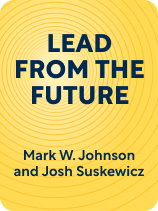

This article is an excerpt from the Shortform book guide to "Lead From the Future" by Mark W. Johnson and Josh Suskewicz. Shortform has the world's best summaries and analyses of books you should be reading.
Like this article? Sign up for a free trial here.
Do short-range concerns leave you without the time to plan for the future of your business? Are you vulnerable to missing out on big opportunities and being caught off guard by major problems?
In Lead From the Future, Mark W. Johnson and Josh Suskewicz offer business leaders a new mindset and strategic approach. This mindset and approach will promote the growth and relevance of their organizations far into the future.
Continue reading for an overview of this how-to book for leaders.
Overview of Lead From the Future
In Lead From the Future, Johnson and Suskewicz argue that, as a business leader, you must develop a compelling future vision for your company and take the necessary steps to bring that vision to life. They show how “future-back thinking,” or what we’ll call visionary planning, lets you envision, plot, and take action to drastically improve your organization’s chances of successful long-term growth.
Mark W. Johnson is a co-founder and senior partner at Innosight, a global innovation consulting firm. He helps companies develop growth strategies and manage innovation and has authored several books, including Dual Transformation and Reinvent Your Business Model. Josh Suskewicz is a partner at Innosight.
We’ll first explore why conventional growth mindsets and strategies often fail. Then, we’ll explore the steps of visionary planning and show how you can adopt the process to improve outcomes for your business. Lastly, we’ll outline how you can embed this approach into your organization’s leadership, teams, and processes to ensure that new generations in the company carry on the visionary planning approach.
Why Use Visionary Planning
No one can predict the future. But the authors argue that, as a business leader, you can improve your organization’s longevity, relevance, and growth in the long term. To do so, you must change your focus from short-term concerns and time horizons to the future you want to see five to 10 (or more) years out.
The authors explain that visionary planning allows you to respond to changing market realities by anticipating threats and opportunities on the horizon, thinking outside your company’s established processes and approaches, reinventing your business or an aspect of it, and meeting unmet demands in the market with innovative products, services, and processes.
Additionally, the authors explain that the visionary planning approach can be applied to different types of organizations other than businesses, like governmental and activist organizations and religious institutions, to help them strengthen their relevance and influence in the long term.
Why Current-State Thinking Is Ineffective
The authors explain what the conventional, short-sighted mindset and strategic approach for business leaders is (what they call present-forward thinking and what we’ll call current-state thinking) and why it leads to failure for many businesses. Current-state thinking happens when you focus solely on solving short-term problems, which leaves you unprepared for looming problems and opportunities. When senior leaders get stuck in current-state thinking, they become attached to the past and reactive to the present. As a result, their companies grow rigid and get bogged down in their processes, regulations, and norms.
Current-state thinking makes your business more vulnerable in today’s environment of volatile markets and rapid technological changes. This is because thinking and planning this way blinds you to transformative opportunities that could assure your company’s stability and growth for decades. The authors explain that senior leaders often don’t take the time to imagine a future in which their current offerings could be obsolete. They assume the future won’t look much different from the present and tend only to think one or two years ahead. Therefore, they don’t take the necessary actions to build toward long-term growth and sustainability.
The Foundation of Visionary Planning
According to the authors, it’s important to understand two foundational aspects of visionary planning—embracing and prioritizing breakthrough innovation and adopting a cyclical learning process we’ll call the discovery cycle. Once you understand these aspects of visionary planning, you can move through the three-stage process of visionary planning.
Breakthrough Innovation
Adopting a visionary planning approach for your organization requires you to shift how you think about and execute innovation. According to the authors, breakthrough innovation—innovation that creates new markets rather than just improving or updating current offerings—is at the heart of long-term growth and relevance. Even if your company is doing well currently, its growth will likely stagnate without effective breakthrough innovation strategies, and your company will fail in the long term.
The authors explain that established companies often overlook the importance of breakthrough innovation because they believe they can survive in the long term by focusing only on improving their company’s core offerings—their fundamental activities, resources, capabilities, and so on. These types of incremental core innovations are necessary to improve efficiency within your company and enhance your current product performance, but they’re not enough on their own to ensure growth and longevity.
Additionally, many executives fail to prioritize breakthrough innovation because they often overestimate the risks of investing in such innovations. As a result, companies tend to fund projects that only improve efficiency and current offerings. But the authors argue that you can manage these risks and, importantly, that the cost of not taking innovation risks is much higher than sticking to safer incremental innovations. The visionary planning mindset broadens your perspective beyond the familiar and prioritizes strategies for breakthrough innovation initiatives, despite the perception of the higher risks it carries.
The Discovery Cycle
The other foundational aspect of visionary planning is an exploratory, cyclical learning approach in which you investigate, imagine, and experiment to develop insights and solutions to problems and opportunities. The steps of the discovery cycle are:
- Investigate: Explore possibilities and develop insights and assumptions about the problem or opportunity by collecting information.
- Imagine: Brainstorm solutions to the problem or innovative ideas.
- Experiment: Test your ideas to yield more insights. Take the insights you gain and return to step one to investigate and develop them further.
This approach supports the visionary planning process, which is not a linear journey from point A to point B but instead is dynamic and constantly evolving in response to changing environments and new insights.
The Three Stages of Visionary Planning
The authors break the visionary process into three stages: Creating the vision, converting the vision to strategy, and executing the visionary plan. They explain that they don’t intend for you to use these stages as a rigid checklist but, instead, as a flexible framework that you can adapt to your company’s unique context and challenges.
The stages of visionary planning work best as a collaborative process that includes regular, structured dialogues between senior leaders informed by the discovery cycle process. These discussions should emphasize exploration over finding consensus and making decisions. The dialogues should include people with diverse perspectives, relevant experience, and knowledge, including those who make resource allocation decisions.
Stage 1: Create Your Vision
First, you must create a vision for your company’s future. This stage involves three steps: anticipating the future market landscape, identifying major implications of this environment for your company, and imagining how your company can fit into that future.
Step 1: Anticipate the Future Landscape
The first task in anticipating what the future landscape will look like is identifying a time horizon—how far into the future to set your vision for the company. The authors recommend you and your team imagine as far into the future as necessary to find the point where you become uncertain of your company’s significance and likely growth. Consider when new paradigms and trends, like technology breakthroughs, may become relevant and mature enough to create market disruptions.
Once you set your target time horizon, discuss what you think the market will look like at this time. Given likely technology and market trends at your target time, what assumptions can you make about market activity? Discuss if there are aspects of your company that would not respond well during these likely disruptions and changes in the future. Additionally, discuss if your customers’ needs will shift and what types of future technology and services you can imagine—or create—to fill those needs.
At this point, it’s important to bring together your team’s differing ideas about what the future will look like and create a clear statement about what you think will happen. This statement should be exciting and should summarize a consensus perspective on the future, which will help shape your strategy and get others to support your vision. For instance, you might predict, “By 2050, all personal assistants and routine customer service tasks will be automated by AI.”
Step 2: Think About How Your Business Will Fare in the Future
In the second step of creating your vision, identify what your company’s future looks like given the assumptions you’ve developed about the future landscape and your current strategies. Discuss with your team whether the company would still have long-term relevance and sustained growth relevance if you continued doing what you’re doing now.
The authors advise that you examine potential threats and opportunities and determine which is likely to play a larger role in your future so that you can develop a strategy to either respond to threats or take advantage of opportunities.
Step 3: Finalize Your Future Vision
Now that you’ve thought about the future landscape at your target time horizon and identified implications for your business, you can construct a future vision. A future vision describes what services or products you’ll offer, how you’ll create value in the market, and how you’ll address necessary factors in future growth—for example, gaps in your company’s current capabilities that need to be modified to support change and growth.
Start with a bird’s eye view of your company’s future by asking yourself: Who will our customers be? What products and services will we offer them? What areas of the world will we serve? What frameworks will we use to organize our company’s activities?
To solidify your vision, the authors recommend you develop a compelling story that describes it. This story should include your company’s larger purpose, a summary of the assumptions you’ve developed about the future, the implications for the business, and how your company will change in response to those implications. A future vision story rooted in your company’s greater purpose will motivate employees and stakeholders and help attract new talent.
Stage 2: Convert Your Vision to Strategy
Now that you have a future vision, you must convert it into a strategy that will bring your vision to life. According to the authors, your strategy contains three connected components (which they call portfolios): your long-term financial picture of your business, innovation roadmap, and resource plan. These components are interdependent and respond to change—you must look at all three together to get a holistic view of your visionary plan and update each component as new insights emerge.
Step 1: Develop a Long-Term Financial Picture of Your Business
Developing a long-term financial picture helps you estimate the revenue and profits your future vision will likely yield. To develop this component of your visionary strategy, you must first identify a growth target that aligns with your future vision, then calculate what the authors call your growth gap and figure out when your growth gap is likely to develop.
Your growth target is an aspirational revenue and profit benchmark for your company at your target time horizon. When identifying a growth target, consider the different areas in which you could pursue growth. You can improve or change your core product or offer supplements to the core product. You might also develop all new products.
After selecting an ambitious but practical growth target, discuss and decide how much growth your core and proximate businesses can realistically deliver by your target time horizon. With this information, you can calculate your growth gap—the difference between what you aspire to deliver and what you are likely to deliver, given your current status. Knowing your growth gap helps you determine how fast and large any new innovative business ventures must be to reach your growth target.
Step 2: Develop an Innovation Roadmap
Your innovation roadmap outlines the steps you need to take to achieve your growth target. This component of your visionary strategy includes your company’s core, proximate, and new growth projects and any undertakings that will develop the company’s capabilities to support growth.
The first task in creating an innovation plan is to develop a timeline. To do this, work backward from your future vision by setting progress markers at around two- to three-year intervals from then until now. For example, with a 10-year target time horizon, figure out what the company should look like and be doing in eight years, then six years, then four. At each progress marker, the authors advise you to check in about a few key aspects of the business: what core and new business initiatives need to be in progress and what new capabilities and structures need to be developed in the business to support these initiatives.
The authors stress that working backward from your future vision is crucial because otherwise, your current processes, regulations, and progress evaluation methods will blind you to innovative possibilities.
Step 3: Develop a Resource Plan
Your resource plan outlines where you’ll invest your financial resources and human resources (such as innovation talent and leadership skills) and where those resources will come from. Developing this plan clarifies where you’ll need to cut funding, which projects to slow down, and which to continue in service of the visionary strategy.
To begin, take stock of the resources you currently have. Then, set an appropriate investment goal for each of your company’s growth areas. Lastly, calculate how far off your target investments are from what you’re currently investing. Each growth area will have distinct expectations for growth, risk, and return, and the authors explain that you must balance these factors to optimize your investment plan.
Stage 3: Realize Your Visionary Plan
At this stage, you’ve formed a vision and developed a new growth strategy in service of your vision. To realize your visionary plan, you must structure your teams to embody your strategy and then execute it.
Step 1: Structure Your Organization to Carry Out Your Strategy
The authors advise that you structure your organization in a way that allows your teams to effectively execute your strategy. To do so, you must involve your senior leadership, position your breakthrough innovation teams for success, and establish a discovery cycle process to oversee new projects.
The senior leadership team’s responsibilities. Senior leadership must be involved in all major decisions about innovation projects. They should oversee projects by balancing efficiency and quality, and protect breakthrough innovation teams from conflicting interests of the business’s core (like funding).
Position breakthrough innovation teams for success. When it comes to building and organizing innovation teams, it’s important to start small and bring together employees from different departments or functions who can work together on a specific project. Look for people with an entrepreneurial mindset who are willing to take risks and have a passion for the project’s vision.
To foster innovation, teams should be organized like startup incubators, competing for funding from the company as they develop their ideas. It’s important to support them with the necessary resources and infrastructure but also to allow them to work independently and take risks. By creating an environment that supports innovation, companies can attract and retain top talent and drive long-term growth.
Step 2: Execute Your Strategy
The execution stage of your visionary plan has three phases—gestation, expedition, and evolution.
In the gestation phase, you test the important assumptions you’ve made about the future landscape. Early on, it’s crucial to create some momentum by validating some of these key assumptions and meeting some early-stage goals. Additionally, the authors recommend you prepare to scale up your initiatives by making changes to your core business that will generate the necessary cash flow. Gestation typically lasts two to three years.
In the expedition phase, your focus shifts away from testing your assumptions and toward standardizing processes, establishing rules, and defining metrics to measure your efficiency and profitability. Expedition typically lasts two to four years.
In the evolution phase, you must decide whether to integrate your new growth initiatives into the core business or keep them separate. If you integrate new growth initiatives, their profits should be similar to the margins of the core business and enhance the core brand. If you don’t integrate them, the new business outgrowths must have their own brand and different rules, metrics, and norms. Evolution typically lasts one to three years.
Make the Visionary Planning Approach a Part of Your Organization
The authors emphasize that visionary planning is not just a process you go through once and then are done with. In order to ensure growth and relevance for your organization in the long run, you must make visionary planning a continued part of how the organization operates. To do so, you must elevate and encourage visionary mindsets and skills in your leaders (including yourself) and institutionalize visionary planning as part of your organization’s processes.
The Visionary Mindset and Skills for Leaders
Leaders with a visionary mindset and skill set successfully implement the visionary planning process and pass their skills and perspectives along to the teams they oversee. The authors explain that visionary thinkers don’t possess a mysterious set of rare traits that make them uniquely capable of envisioning possibilities and mobilizing opportunities—they simply work to keep a broad perspective, and they maintain an optimistic attitude about the possibility of change. Additionally, to be a successful visionary leader, the authors recommend you do the following:
- Become familiar with the discovery cycle process and get comfortable investigating, envisioning, and experimenting with ideas.
- Develop the mental flexibility to switch between current-state thinking and visionary planning.
- Continually rethink and reshape your visions for the company’s future based on emerging data.
Organizational Processes
To build a visionary planning mindset into the processes and structures of your organization, you must create a culture where no one is afraid of being judged for exploring and developing their talents, as this limits people’s ability to imagine the future and innovate. Foster an egalitarian company culture that values everyone’s ideas. Additionally, it’s important to prioritize inclusiveness and demographic diversity because differing perspectives contribute to a broader understanding of your customers and open-mindedness to new ideas on every level of the organization.
The authors explain that it’s important to tirelessly communicate your vision and larger purpose with your employees to ensure everyone understands it and knows how they can contribute to it. Studies have shown that being connected to the larger mission improves productivity and employee retention. Additionally, it’s essential to have clear, concrete goals that employees, customers, and investors can connect to and support. By having a clear vision and purpose and communicating it effectively, you can cultivate a visionary planning mindset throughout your organization.

———End of Preview———
Like what you just read? Read the rest of the world's best book summary and analysis of Mark W. Johnson and Josh Suskewicz's "Lead From the Future" at Shortform.
Here's what you'll find in our full Lead from the Future summary:
- Why it's important to anticipate future change rather than reacting to it
- A three-stage framework for staying ahead of the competition
- How to understand and adopt the visionary planning process






